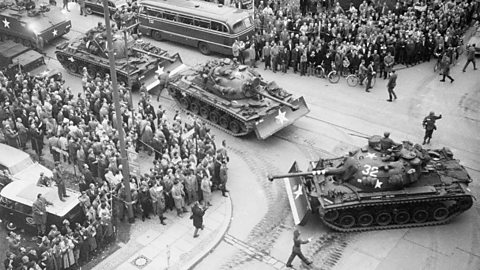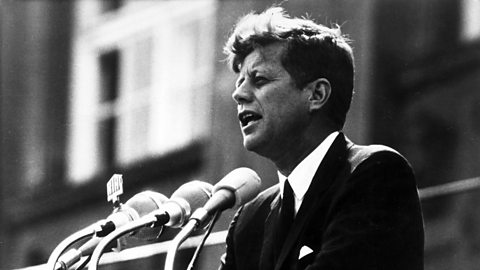The US response to the Berlin Wall
Alarmed by the building of the Berlin Wall, President Kennedy sent his Vice-President, Lyndon Baines Johnson, and US General, Lucius D Clay to Berlin.
Stand-off at Checkpoint Charlie

Once the Wall had been constructed, the US decided to test how far they could push the USSRUnion of Soviet Socialist Republics - collection of states, also known as the Soviet Union.. Foreigners were still allowed to cross the Wall, and the US regularly sent troops and diplomats into the Soviet sector through Checkpoint Charlie, one of the guarded crossing points between East and West. Both sides were entitled to do this under the Four Powers Agreement made after the Yalta ConferenceA meeting of Churchill, Stalin and Roosevelt in 1945, where they planned the warās end, the division of Germany into occupation zones and how post-war Europe should be organised. .
On 27 October 1961 Red ArmyArmy of the USSR. tanks pulled up to Checkpoint CharlieThe main crossing point in the Berlin Wall between the East and West Berlin. There was a standoff between American and Soviet tanks here when the wall was first built in 1961. and refused to allow Americans to pass into the Eastern sector. All day long the two sides, with tanks and soldiers at the ready, faced each other in a tense stand-off. The nail-biting crisis lasted for 18 hours until a diplomatic agreement was reached and both sides began to slowly back down.
Once again it was very clear that the US would not take military action against the Soviet Union in its own geographical and political sphere of influence, and risk open conflict between the two nuclear superpowerCountries who have huge influence or strength, giving them significant global power.. There was no attempt at rolled backAn American policy to not just contain communism, but turn communist countries back to capitalism. in Berlin, and the East was allowed to remain cut off and isolated from the West.
Revision tip
Keep a record of all the various crises in relations between the US and the USSR from 1948 to 1968.
For each crisis you should record:
- Why was there a risk of war in the crisis? Eg in Hungary in 1956, the Hungarian rebels were being violently repressed by the Soviet army and in the Truman Doctrine, the US had said they would defend people being oppressed by communism.
- Which side had the upper hand in the crisis? Eg in 1956 the Soviets held the upper hand in Hungary because it was within their sphere of influence in Eastern Europe and they already had troops stationed there.
- Which side decided to avoid an action that could provoke armed conflict? Eg the US took no action to support the Hungarian rebels.
You should complete this exercise for each of these years: 1948, 1956, 1960, 1961, 1962 and 1968.
President Kennedy visits Berlin

On 26 June 1963, President John F Kennedy visited Berlin and made a famous speech in which he claimed that Berlin was a symbol of freedom in the international struggle against communismA classless society where all property is owned publicly.. It was a strong, defiant message and put an end to Soviet hopes of driving the Allies out of Berlin. However, the Berlin Wall remained a symbol of Cold War tension until it was torn down in November 1989.
During his famous speech Kennedy declared āIch bin ein Berlinerā (a phrase intended to mean āI am a citizen of Berlinā). His intention was to show that he was standing alongside the citizens of Berlin in their struggle against communism. Unfortunately a 'Berliner' is also a type of German jam doughnut and so many misinterpreted the statement and claimed that Kennedy said āI am a jam doughnutā!
"Ich bin ein Berliner" speech